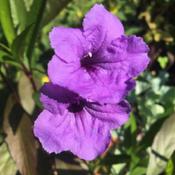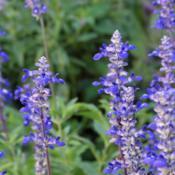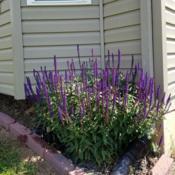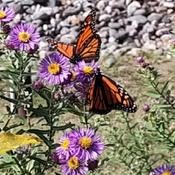| Image | Plant | Status | Notes | Events |
|---|---|---|---|---|
 |
Mexican Petunia (Ruellia simplex) |
Have Perennial Garden |
||
 |
Meadow Sage (Salvia Sallyrosa™ April Night) |
Have Perennial Garden |
April 25, 2021: Obtained plant | |
 |
Mealy Cup Sage (Salvia farinacea 'Blue Bedder') |
Have Perennial Garden |
https://www.homedepot.com/p/Fe... https://www.outsidepride.com/s... Sow: indoors Dec 15-Mar 15 Depth: Light is required for germination Germination: 10-30 days Maturity: 90-100 days |
April 24, 2021: Obtained plant April 24, 2021: Seeds sown April 2, 2022: Transplanted April 15, 2023: Transplanted |
 |
Meadow Sage (Salvia nemorosa Apex™ Pink) |
Have Perennial Garden |
Cuttings: Sept | April 4, 2021: Obtained plant |
 |
Sage (Salvia nemorosa 'Caradonna') |
Have Perennial Garden |
April 26, 2021: Obtained plant April 26, 2021: Cuttings took September 10, 2022: Cuttings took |
|
 |
Maltese Cross (Silene chalcedonica) |
Have Perennial Garden Wintersow |
https://www.edenbrothers.com/s... Wintersow, spring or fall |
September 12, 2021: Seeds sown April 10, 2022: Seeds sown June 20, 2022: Bloomed |
 |
White rosinweed (Silphium albiflorum) |
Prev Perennial Garden |
did not live to maturity | April 24, 2021: Obtained plant April 24, 2021: Seeds sown (https://www.seedsource.com/cat...) |
 |
New England Aster (Symphyotrichum novae-angliae) |
Have Perennial Garden |
Deadhead aster flowers to keep them looking good and to encourage more blooms to form. Cut aster plants back hard after flowering in late autumn. In midsummer, pinch out the top shoots to encourage flowers. Mildew is a common problem among many aster varieties, particularly the North American varieties. Keep plants well-watered and don't let the soil dry out, Feed them with bone meal It has been used by indigenous Americans, such as the Cherokee, Iroquois, and Potawatomi, to heal multiple ailments. The vernacular name "Michaelmas daisy" derives from the various asters, including this species, that tend to flower around September 29, the Feast of St. Michael.[23] The word "aster" was used to describe a star-like flower as early as 1542 in De historia stirpium commentarii insignes, a book by the German physician and botanist Leonhart Fuchs. An old common name for Astereae species using the suffix "-wort" is "starwort", also spelled "star-wort" or "star wort". An early use of this name can be found in the same work by Fuchs as Sternkraut, translated from German literally as "star herb" (Stern Kraut).[24] The name "star-wort" was in use by Aiton in his 1789 Hortus Kewensis for Aster novae-angliae. He used the common names "New England cluster'd star-wort" and "New England panicl'd star-wort" in this work.[25] New England aster is native to most of the central and northeastern United States and southeastern Canada, Habitat S. novae-angliae is found in a wide variety of open, typically moist habitats, including meadows, prairies, marshes, fens, forest edges, and disturbed anthropogenic sites, such as roadsides and former agricultural fields.[3][32] In its native habitat, it grows primarily in moist calcareous soils,[33] favoring more marshy-wet sites in the western-most of its range.[34] It is categorized on the United States National Wetland Plant List (NWPL) with the Wetland indicator status rating of Facultative Wetland (FACW) in all wetland regions, meaning it usually occurs in wetlands, but not out of necessity.[35] For example, in one northern location, the Niagara Peninsula in southern Ontario, it was found to grow in dry and sandy soils. The seeds of S. novae-angliae are an important fall and winter food source for songbirds.[26] Further, a wide variety of generalist nectar-feeding insects visit the plant, including butterflies, moths, ants, flies, and bees. It is heavily visited by long-tongued bumblebees, including the golden northern bumble bee (Bombus fervidus) and the half-black bumblebee (Bombus vagans), and less so by short-tongued species.[13] Some bees will collect pollen in addition to nectar, such as the broad-handed leafcutter bee (Megachile latimanus) and Drury's long-horned bee (Melissodes druriellus). Bees and butterflies frequent this wildflower. Nectar source for Monarch butterflies. A host plant for Pearl Crescent Butterfly Phyciodes tharos |
|
 |
New England Aster (Symphyotrichum novae-angliae 'Purple Dome') |
Have Perennial Garden |
April 14, 2022: Transplanted | |
 |
Spiderwort (Tradescantia ohiensis) |
Have Perennial Garden |
||
 |
Verbena (Verbena peruviana EnduraScape™ Pink Fizz) |
Prev Perennial Garden |
April 10, 2021: Obtained plant | |
 |
Garden Verbena (Verbena x hybrida) |
Have Perennial Garden |
https://www.edenbrothers.com/s... | May 16, 2021: Seeds sown May 1, 2022: Seeds sown |
 |
Verbena (Verbena x hybrida EnduraScape™ Red) |
Have Perennial Garden |
a | April 25, 2021: Obtained plant |